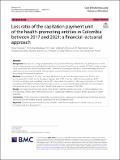| dc.contributor.author | Espinosa, Oscar | |
| dc.contributor.author | Rodríguez, Jhonathan | |
| dc.contributor.author | Urdinola, B. P. | |
| dc.contributor.author | Do Nascimento Silva, Pedro L. | |
| dc.contributor.author | Sánchez, Alejandra | |
| dc.contributor.author | Arias, Martha-Liliana | |
| dc.contributor.author | Valdez, Emiliano A. | |
| dc.contributor.author | Cheng, Terence | |
| dc.contributor.author | Fisher, Sara-Ellison | |
| dc.date.accessioned | 2023-10-10T18:45:14Z | |
| dc.date.available | 2023-10-10T18:45:14Z | |
| dc.date.issued | 2023-10-04 | |
| dc.identifier.uri | https://hdl.handle.net/1721.1/152401 | |
| dc.description.abstract | Abstract
Background
Because of a change of government, the Colombian Ministry of Health and Social Protection is in the process of presenting a structural reform for the General System of Social Security in Health (GSSSH), in order to implement a ‘preventive and predictive health model’. However, it will always be relevant to review and analyze the fiscal implications of any proposed public policy program, to protect financial sustainability and to promote the better functioning of the system in question.
Methods
To contribute to this topic, we have calculated, using a financial–actuarial approach, the loss ratio for the years 2017 to 2021 for the Capitation Payment Unit (CPU) for all the Health-Promoting Entities (HPE) for both contributory and subsidized schemes. This information, derived from public reports available on the official website of the National Health Superintendency, allows us to estimate the financial burden of the institutions that guarantee access to and provision of health services and technologies in Colombia.
Results
The study shows that close to half of the HPEs in Colombia (which represent 11.6 million affiliates) have CPU loss ratios of more than 100% for the year 2021, evidencing insufficient resources for the operation of health insurance.
Conclusions
Finally, we propose some policy recommendations regarding the strengthening of informed decision-making to allow the healthy financial sustainability of the Colombian GSSSH. | en_US |
| dc.publisher | BioMed Central | en_US |
| dc.relation.isversionof | https://doi.org/10.1186/s12962-023-00481-5 | en_US |
| dc.rights | Creative Commons Attribution 4.0 International license | en_US |
| dc.rights.uri | https://creativecommons.org/licenses/by/4.0/ | en_US |
| dc.title | Loss ratio of the capitation payment unit of the health-promoting entities in Colombia between 2017 and 2021: a financial–actuarial approach | en_US |
| dc.type | Article | en_US |
| dc.identifier.citation | Cost Effectiveness and Resource Allocation. 2023 Oct 04;21(1):73 | en_US |
| dc.contributor.department | Massachusetts Institute of Technology. Department of Economics | |
| dc.identifier.mitlicense | PUBLISHER_CC | |
| dc.identifier.mitlicense | PUBLISHER_CC | |
| dc.eprint.version | Final published version | en_US |
| dc.type.uri | http://purl.org/eprint/type/JournalArticle | en_US |
| eprint.status | http://purl.org/eprint/status/PeerReviewed | en_US |
| dc.date.updated | 2023-10-08T03:12:13Z | |
| dc.language.rfc3066 | en | |
| dc.rights.holder | BioMed Central Ltd., part of Springer Nature | |
| dspace.embargo.terms | N | |
| dspace.date.submission | 2023-10-08T03:12:13Z | |
| mit.license | PUBLISHER_CC | |
| mit.metadata.status | Authority Work and Publication Information Needed | en_US |
